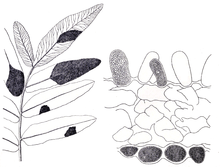Mixiomycetes
| Mixiomycetes | |
|---|---|
 | |
| Scientific classification | |
| Kingdom: | Fungi |
| Division: | Basidiomycota |
| Subdivision: | Pucciniomycotina |
| Class: | Mixiomycetes R.Bauer, Begerow, J.P.Samp., M.Weiss & Oberw. (2006)[1] |
| Order: | Mixiales R.Bauer, Begerow, J.P.Samp., M.Weiss & Oberw. (2006)[1] |
| Family: | Mixiaceae C.L.Kramer (1987)[2] |
| Genus: | Mixia C.L.Kramer (1958)[3] |
| Type species | |
| Mixia osmundae (Nishida) C.L.Kramer (1958)[3] | |
The Mixiomycetes are class of fungi in the Pucciniomycotina subdivision of the Basidiomycota. The class contains a single order, the Mixiales, which in turn contains a single family, the Mixiaceae that circumscribes the monotypic genus Mixia. Only one species has been described to date, Mixia osmundae; this species was originally named Taphrina osmundae by Japanese mycologist Toji Nishida in 1911.[4] It is characterized by having multinucleate hyphae, and by producing multiple spores on sporogenous cells.[1]
References
- 1 2 3 Bauer R, Begerow D, Sampaio JP, Weiss M, Oberwinkler F (2006). "The simple-septate basidiomycetes: a synopsis". Mycological Progress. 5 (1): 41–66. doi:10.1007/s11557-006-0502-0.
- ↑ Kramer CL. (1987). "The Taphrinales". Studies in Mycology. 30: 151–166.
- 1 2 Kramer CL. (1958). "A new genus in the Protomycetaceae". Mycologia. 50 (6): 916–926. doi:10.2307/3755913. JSTOR 3755913.
- ↑ "Mixia osmundae (Nishida) C.L. Kramer 1959". MycoBank. International Mycological Association. Retrieved 2011-11-27.
This article is issued from Wikipedia - version of the 11/20/2016. The text is available under the Creative Commons Attribution/Share Alike but additional terms may apply for the media files.